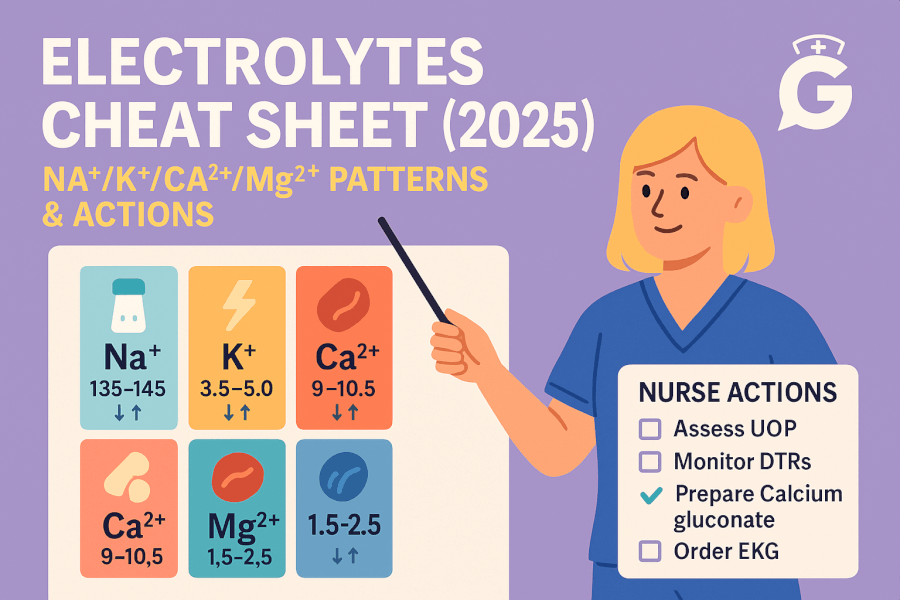The NCLEX exam doesn’t just test your memory — it tests your ability to apply nursing knowledge in real clinical scenarios. And one of the most frequently tested content areas is respiratory disorders.
From asthma to tuberculosis, this guide gives you a comprehensive breakdown of the most important respiratory conditions, nursing priorities, and interventions — everything you need to feel confident on exam day.
Understanding Respiratory Disorders
Respiratory disorders affect the airways, lungs, and structures responsible for breathing. These can be acute (sudden and short-term) or chronic (long-term and progressive).
Commonly tested respiratory disorders on the NCLEX include:
- Asthma
- Chronic Obstructive Pulmonary Disease (COPD)
- Pneumonia
- Tuberculosis (TB)
You'll also need to master assessment skills, oxygenation interventions, and patient teaching strategies for each.
For more support applying these concepts, explore How to Use AI to Study for the NCLEX in 2025 — featuring tools that break down topics like these with adaptive learning.
Asthma
Asthma is a chronic inflammatory disorder of the airways that causes:
- Wheezing
- Shortness of breath
- Chest tightness
- Coughing, especially at night or early morning
Pathophysiology:
Triggers (e.g., allergens, exercise, cold air) cause inflammation and bronchoconstriction, narrowing the airways.
NCLEX Tips:
- Know the difference between rescue meds (albuterol) and maintenance meds (inhaled corticosteroids).
- Recognize signs of status asthmaticus (life-threatening asthma exacerbation).
Chronic Obstructive Pulmonary Disease (COPD)
COPD includes two conditions:
- Chronic bronchitis: Inflammation of bronchi with mucus production
- Emphysema: Destruction of alveoli, leading to poor gas exchange
Key Symptoms:
- Chronic productive cough
- Dyspnea on exertion
- Barrel chest (emphysema)
- Digital clubbing
- Hypoxia/hypercapnia
Nursing Interventions:
- Administer low-flow oxygen (2 L/min max)
- Encourage pursed-lip breathing
- Promote smoking cessation
Learn how to tie this into your clinical approach with our Physiological Adaptation Concepts & Mnemonics.
Pneumonia
Pneumonia is an infection that causes inflammation of the alveoli, often filling them with fluid or pus.
Causes:
- Bacterial (e.g., Streptococcus pneumoniae)
- Viral (e.g., influenza)
- Fungal or aspiration-related
Symptoms:
- Fever, chills
- Productive cough
- Dyspnea
- Crackles on auscultation
Nursing Priorities:
- Administer prescribed antibiotics or antivirals
- Monitor respiratory status and oxygen saturation
- Encourage incentive spirometry
📌 Deep dive: Nursing Care Plan for Community-Acquired Pneumonia (CAP)
Tuberculosis (TB)
TB is a bacterial infection (caused by Mycobacterium tuberculosis) that mainly affects the lungs but can spread to other organs.
Key Points:
- Spread via airborne droplets
- Patients with active TB must be in negative pressure rooms
- Meds include RIPE therapy: Rifampin, Isoniazid, Pyrazinamide, Ethambutol
Symptoms:
- Persistent cough (>3 weeks)
- Hemoptysis (coughing blood)
- Night sweats
- Weight loss, fatigue
📌 Use this to reinforce airborne precautions and PPE protocol questions.
Respiratory Assessment and Interventions
In addition to knowing the conditions, the NCLEX also expects you to know how to assess and respond to respiratory issues.
Assessment Skills:
- Lung sounds (crackles, wheezing, diminished)
- Work of breathing
- Pulse oximetry
- Respiratory rate and pattern
Diagnostic Tests:
- Chest X-ray
- ABGs (arterial blood gases)
- Pulmonary function tests
- Sputum culture
Core Nursing Interventions:
- Elevate HOB (semi-Fowler's or Fowler’s)
- Administer oxygen therapy per order
- Encourage deep breathing, coughing, incentive spirometry
- Suction as needed (for airway clearance)
🩺 Review more about core organ assessments in Vital Organs You Need to Know for the NCLEX
Sample NCLEX-Style Question
A nurse is caring for a client with emphysema. Which of the following interventions is most appropriate?
- A) Encourage the client to drink 3 liters of fluid/day
- B) Administer oxygen via non-rebreather mask at 15 L/min
- C) Instruct the client to exhale through pursed lips
- D) Maintain client in supine position
✅ Correct answer: C. Pursed-lip breathing helps prolong exhalation and improves gas exchange in COPD.
Conclusion
Respiratory disorders like asthma, COPD, pneumonia, and tuberculosis are common on the NCLEX — and even more common in real-world nursing. But you’re not just memorizing symptoms — you’re learning to assess, prioritize, and take action.
Take your time mastering:
- Pathophysiology
- Nursing interventions
- Patient education
- Precaution levels (droplet, airborne)
And most importantly: Apply it clinically. The more you understand the why, the easier it is to pick the right answer on test day.
Keep Studying With These NCLEX Favorites
- Nursing Care Plan for Pneumonia (CAP)
- Vital Organs for the NCLEX
- Physiological Adaptation Concepts & Mnemonics
- How to Use AI to Study for the NCLEX in 2025
- Top 10 AI-Powered NCLEX Study Tips







